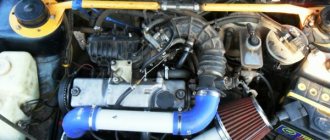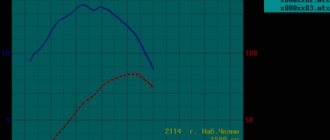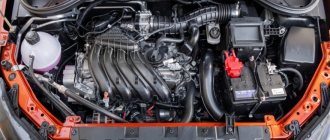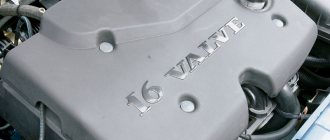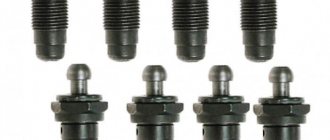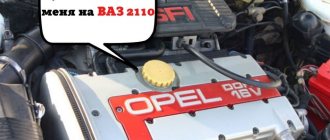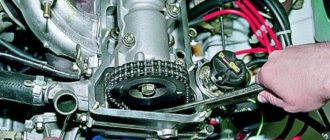Installing a turbine is the most common way to increase the power of VAZ cars. Atmospheric modification of the engine with a cylinder head bore, a sports exhaust system and sports shafts will be more affordable, but it is limited to a limit of 120-130 hp. Proper turbocharging allows you to remove more than 200 horses from a car. When choosing between turbocharged and naturally aspirated engines, proceed from the tasks assigned to the car. Refinement of the naturally aspirated engine allows you not to get lost in city traffic among more powerful foreign cars. Turbo is better for racing.
Where to begin
Installing a turbine on any car begins with a thorough examination of the hardware.
You can’t just go to the store and buy a ready-made kit. And even if it is possible, the system will still have to be modified. VAZ 2114 turbocharged engine
If you take on this task, consider the following:
• A number of VAZ 2114 stock units are unsuitable for a car with a power of over 150 hp. It will not be possible to do without re-equipping the suspension and brakes, installing wider wheels with a turbo engine. • Tuning foreign cars is somewhat easier if the model being tuned has “bigger” brothers with turbo engines. Tuning usually comes down to searching, purchasing and adjusting ready-made factory units. It’s more difficult with Togliatti-made cars - VAZs don’t install turbines. Fortunately, in large cities there are tuning studios that develop and produce tuning parts. True, their products are mostly unlicensed, so there will be problems with legalizing changes. • The correct choice of turbine is the key to successful turbo tuning. Before realizing your dream, we recommend that you read brief descriptions of the turbines used to modify the VAZ.
Turbo engine VAZ 11192: characteristics and features
Mass production of the unit with the VAZ-11192 index should begin in 2022.
The displacement is typical for downsizing engines - 1390 cm³. The cylinder diameter is 76.5 mm, the piston stroke is 75.6 mm. If preliminary data is to be believed, the turbo engine corresponds to the world level in its main indicators: maximum power is 110 kW (149.6 hp) at 5600 rpm, and maximum torque is 240 Nm at 2000 rpm. The return, as you might guess, was adjusted to a tax-advantageous amount.
In the future, it is possible that a more charged version will appear - for sports modifications of Tolyatti cars.
The VAZ-11192 differs from its predecessor in a modified cast-iron cylinder block, a lightweight crankshaft, a new connecting rod and piston group, a cylinder head, and a gas distribution mechanism.
Other new components: turbocharger, intake module, exhaust manifold, exhaust pipe with converter, injector rail, oil and water pumps.
New KIA Optima 2022 configurations and prices in Russia Volkswagen Tiguan 2016 Nissan Qashqai 2022 new body: configurations and prices, photos
What cars was the engine designed for? It was addressed primarily to Vesta.
And in our market, the engine will most likely be in demand - it just begs to be under the hood of cars in the maximum configuration.
Automotive news from around the world
Acura MDX 2017Kia Mohave 2016Maserati Levante 2017
However, another serious question arises: which box should he choose to pair it with? Most likely, something from the Renault-Nissan alliance line. After all, existing domestically produced mechanical gearboxes cannot handle such a high torque, and an imported unit will not be cheap.
Therefore, it is possible that the 1.8-liter naturally aspirated VAZ-21179 engine, developing a power of 90 kW (122.4 hp) and a maximum torque of 170 Nm, will remain top on the Russian market. Moreover, its modernization continues. For example, in addition to variable phases at the inlet, variable phases at the outlet will appear.
Such a motor will receive the VAZ-21178 index and will produce 100 kW (136 hp) and 175 Nm.
Is it possible to make an electric version with your own hands?
What is an 8 valve engine in 2114
Hypothetically possible, and many people install this in their car. Personally, I also thought about installing it on my car, but the price stopped me.
You need to solve a number of points:
1) Definitely installing a powerful generator, which is already expensive for a foreign car.
2) A powerful and compact electric motor, preferably brushless, it produces high speeds with optimal energy consumption. Personally, I have seen these for compact models, but with a power of 0.5 kW and above they are also not cheap.
3) Impeller and housing. You also need to make it yourself or buy it for maximum air injection. Also not an easy task.
4) And of course, a stabilizer or inverters to power the electric motor.
The tasks are not simple, some foreign cars do not have powerful generators, so it is very difficult to do!
But many craftsmen install it on their cars in the garage; an increase in power can actually be achieved up to 20 - 30%.
Moreover, many people install an additional air consumption sensor in the pipe in front of the turbine; it “sees” the pumped volume and automatically regulates a larger fuel supply (supplies values to the ECU) to enrich the fuel mixture. So the firmware may not be needed.
To make your vehicle run more efficiently, automobile manufacturers often resort to turbocharging systems. But will the new type of turbocharger have such a positive effect on engine performance? To make a car's fuel consumption much lower, manufacturers often use one key solution - reducing the volume of the power unit. But among other things, in order for the performance of such engines to remain at a decent level, they usually install turbochargers that are controlled by the exhaust and have a delay, which is better known as “turbo lag”.
Cars have been subject to this problem for many years in a row, which was accompanied by constant complaints and dissatisfaction from the owners. What seemed to be a panacea was found - the simultaneous installation of two turbines, which minimized the effect of the turbo pit. But this, alas, did not become the key decision.
History of the Electric Turbine
After a long period of development, the electric turbine is ready for mass use. Controlled Power Technologies (CPT) was the first to announce this.
from Britain. The electric turbocharger, they say, is ready for mass production. SRT management has already signed an agreement with Switched Reluctance Drives Limited to develop an OEM module based on this technological base.
Switched Reluctance Drives will be engaged in mass production of electric compressors. British developers, meanwhile, have already succeeded in creating real electric compressors for internal combustion engines. The CPT turbocharger will be installed on any engine: naturally aspirated, turbocharged diesel or gasoline.
Controlled Power Technologies has been developing the electric turbine for almost eight years, work on it began at the beginning of the 21st century. The creators of the electric turbine claim that it can operate from an on-board power supply of 12 volts, and its use will save the engine from the effect of turbo lag, and will also operate the supercharger even at low speeds. The peculiarity of this technology is the use of regenerative energy. The back pressure that was previously released through the blow-off bypass valve when the accelerator is reset is now directed to rotate the flywheel turbine blades, allowing power to be generated and the battery to be charged.
A prototype of a machine with an electric turbine was developed by the German company AVL List.
The electric supercharger has been adapted to the two-liter petrol engine with direct fuel injection. Such a power unit, which was installed on the Volkswagen Passat, pollutes the atmosphere very delicately, so to speak, only 159 grams per kilometer, and this is as much as 20 percent less than a similar traditional 2.0 TFSI with the same power, and less, than a 170-horsepower turbodiesel with the same volume.
Installation Features
How much does an 8 valve engine on a VAZ 2110 weigh?
A compressor of this type for a VAZ involves the use of the following factory elements: cylinder block, crankshaft, connecting rods, camshaft and valves. Differences in additional elements are associated only with the pistons and cylindrical head due to the need to reduce compression during installation. This functional feature is achieved by expanding the combustion chamber or special pistons. But, there is a version that the latter may be factory-made, and you can limit yourself to replacing the head.
The turbine on the VAZ 2107 injector also has differences in output. It fills the area between the receiving pipe and the exhaust manifold. The factory components will remain the muffler and resonator. If you need to get more power, it is better to use the recommendations for installing a direct-flow type exhaust. Injection requires a larger receiver and a non-standard control solution. The lubrication system is also subject to certain changes. As a result, the most expensive element is the turbine.
Nuances of work
Why is a turbocharger attractive to a VAZ owner? The volumes of fuel that burn out inside the cylinders are closely related to the amount of air entering the injector during startup. Enrichment of the liquid requires reducing power. In order to remove this limitation, the cylinder requires a much larger supply of air when excess pressure is pumped. Just like that, increased pressure by thirty percent triggers the required level of increase in power and dynamic acceleration.
The operation of a compressor of this type on an injector is extremely simple. The housing is fixed to the exhaust manifold. At the core of the device there is a turbine wheel connected to a compressor wheel. The exhaust gas stream spins the turbine. Then, through the shaft, the moment goes to the compressor impeller, which sucks in air through the corresponding filter, then transferring it to the carburetor already compressed, thus increasing the level of saturation of the cylinders.
So cylinders of equal volume pump working mixtures in large numbers. Conventional VAZ engines have a 25 percent combustion level of the pumped fuel due to lack of oxygen.
Increased air filling includes a uniform increase in the amount of fuel burned.
This fact will affect the efficiency level of the motor. As a result, the supercharger will allow you to pump large volumes of gasoline over a similar period of time. The instantaneous characteristics will also increase, affecting the acceleration dynamics.
A little theory
Toyota Sera 1.5 turbo 4WD Serafima Logbook MythBusters FHE connecting rods
Such improvements can be carried out more effectively by those who have a clear understanding of their own actions. To do this you need to understand the theoretical part.
So, the car’s power and fuel consumption depend on the properties and degree of enrichment of the fuel-air mixture entering the cylinders, as well as on its volume.
The fact is that an ordinary engine, when operating, pumps air into itself due to the vacuum created by the piston. In a turbocharged power unit, this work is done by a turbocharger. At the same time, the air is compressed earlier, which allows you to pump in a larger volume. In other words, you can burn a larger volume of fuel. The result is an increase in engine power in relation to engine volume and fuel consumed.
One fundamental point: air, as is clear, heats up under strong compression. Secondly, it will heat up during compression in the combustion chamber. With all this, detonation may occur. And, in addition, due to heating, the air density in the cylinder will decrease, which will naturally reduce the efficiency of the entire system. To remove these bad phenomena, intercoolers are used - air coolers from the turbine. They are a radiator.
As already mentioned, there are two types of compressors:
- A turbocharger that operates by using the energy of exhaust gases. The processed gases enter the impeller and spin it, which is why air is pumped;
- Mechanically driven compressor. It is powered by a motor drive. With all this, efficiency decreases and fuel consumption increases compared to the first version of the compressor, because the mechanical supercharger takes away part of the power from the internal combustion engine.
The entire system, not counting the turbine itself, contains several more fundamental components that need to be kept in mind during installation:
- a control valve that maintains this pressure;
- a bypass valve, which ensures that compressed air returns back to the compressor inlet pipes if the engine throttle valve is closed;
- a bleed valve that releases compressed air into the atmosphere when the throttle valve is closed;
- air pipes;
- oil pipes (serve for lubrication and cooling of the turbine).
Hi all ! In this video I will talk about the design of a turbo engine in our implementation. Enjoy watching.
Refinement and modernization of the carburetor. The main shortcomings of the carburetor injection system and methods for eliminating them, settings. Intake manifold tuning.
Turbines for VAZ cars
Installing LPG on a diesel engine
There are many options for installing a turbine on the 2114 model. Theoretically, anything can be adapted, but the following models are best suited for an 8-valve engine:
- Garret 1752;
- Mitsubishi TD04 (installed on Mitsubishi Lancer EVO, Subaru Impreza WRX, and some other models);
- IHI VF10 (this model was equipped with the 1st generation Subaru Legacy cars), as a variant of the VF11-20 (stock for the 2nd generation Legacy);
The list can be expanded with dozens of positions, including more powerful turbines TD05, TD06, VF23-30.
Moreover, if there is not enough money for new equipment, it is not difficult to find used kits in decent condition due to the transition of their owners to more powerful equipment
Installing a turbo on a VAZ 2114 where to start
Installing a turbine on any car begins with a painstaking study of the hardware. Chinese TURBINE for VAZ 2109 and Top subwoofer! We install a cheap TURBINE on a VAZ. Part. You can’t just come to the store and buy a ready-made set. And even if it is possible, the system will still have to be modified.
Turbocharged engine VAZ 2114
If you take on this task, consider the following:
- A number of stock units of the VAZ 2114 are not applicable for a car with a power exceeding 150 hp. It will not be possible to do without re-equipping the suspension and brakes, installing wider wheels with a turbo engine.
- Tuning foreign cars is partly easier if the model being tuned has “bigger” brothers with turbo engines. How to install a turbine on a D-240 engine. Detailed information about the product/service and supplier. A turbine on a VAZ is numerically expressed as 1 which nevertheless installed a turbine on. Tuning usually comes down to searching, purchasing and adjusting ready-made industrial components. It’s more difficult with Togliatti-made cars - they don’t install turbines on the Voila. Fortunately, in large towns there are tuning studios that develop and create tuning parts. True, their products are mainly unlicensed, so there will be difficulties with the legalization of configurations.
- The right choice of turbine is the key to successful turbo tuning. Before realizing your dream, we advise you to read short descriptions of the turbines used to modify the VAZ.
Installation of a turbine on a VAZ 2107
Installing a turbine allows you to double the power of the VAZ 2107 engine without increasing fuel consumption.
Reasons for installing a turbine on a VAZ 2107
Installing a turbine on a VAZ 2107 will allow:
- reduce vehicle acceleration time;
- reduce fuel consumption of injection engines;
- increase engine power.
Turbine operating principle
To increase engine power, you need to make the supply of the fuel-air mixture to the combustion chambers more intense. The turbine crashes into the exhaust system, is driven by a stream of exhaust gases and, using the energy of these gases, increases the pressure in the power unit. As a result, the rate of mixture entering the cylinders increases.
Under normal conditions, the VAZ 2107 engine has a gasoline combustion rate of about 25%. After installing a turbocharger, this figure increases noticeably and the engine efficiency increases.
Installing a turbine allows you to make the engine more powerful without increasing fuel consumption
Choosing a turbine for VAZ 2107
There are two types of turbines:
- low-performance (boost pressure 0.2–0.4 bar);
- high-performance (boost pressure 1 bar and above).
Installing a second type turbine will require a major engine upgrade. Installation of a low-performance device will ensure compliance with all parameters regulated by the automaker.
Before turbocharging the VAZ 2107 engine you will need:
- Intercooler installation. When using a turbine, the air heats up to 700°C. Without additional cooling, not only can the compressor burn out, but the engine itself can be damaged.
- Conversion of a carburetor fuel supply system to an injection system. A weak intake manifold on carburetor engines will not withstand the pressure of the turbine and may rupture. On units with a carburetor, you can install a compressor instead of full turbocharging.
In general, the advantages of the VAZ 2107 turbocharged engine are very doubtful. Therefore, before installing a turbine on a discontinued car with modest technical characteristics, you should carefully evaluate the feasibility of the decision being made. It is much easier to install a compressor on a VAZ 2107. In this case:
- there will be no excess pressure in the system that could destroy the manifold, car suspension, etc.;
- no need to install an intercooler;
- no need to convert the carburetor system to an injection system;
- the cost of re-equipment will be reduced - the complete compressor costs about 35 thousand rubles, which is much lower than the cost of the turbine;
- Engine power will increase by 50%.
Installing a compressor on a VAZ 2107 is much simpler, safer and more profitable than installing a full-fledged turbine
I had to watch with my own eyes how a VAZ 2107 with a turbocharged engine rushes. It is difficult to overtake it on the highway, but the car cannot maintain speed for a long time, in my opinion, although I have not driven it myself.
Turbine installation, parts procurement
Lada 2108 SMG Sanych motors Garag Logbook 50 TURBO
Assembling a turbo car is a creative process, much (if not all) depends on the designer that you assemble.
It is impossible to give unambiguous advice here - all answers are only specific.
In the VAZ store you will need to purchase:
- new pistons (usually Niv ones are used);
- rings (the higher quality the better);
- cylinder head gasket (iron, suitable from Kalina for 8 valves);
- fuel regulator at 2.5-3 bar;
- throttle;
- vacuum tubes, tees, bends, etc.
Simple turbo kit for VAZ 2114
- turbocharger (from the above or whichever you like);
- gaskets (pipe, downpipe, oil drain);
- inlet receiver;
- exhaust manifold (there are ready-made solutions for Garrett and TD04; for other turbines you will have to assemble it yourself);
- a set of pipes, clamps and other small things (ready ones available);
- intercooler (you can start without it, it gives an additional increase of up to 10 hp);
- fuel pump (with a capacity of about 250 l/h, the better the quality, the better);
- injectors (budget option - from Volga, more productive - from Subaru or Mitsu Evo);
- blow-off (bypass valve for excess air pressure in the turbine, deserves a separate discussion);
- boost controller (for the VAZ 2114 it is better to use a mechanical one, it is simpler and cheaper, however, you can install an electronic one);
- absolute pressure sensor (ABP), air temperature sensor (ATS), turbine pressure sensor (TP).
The budget can start from 40-45 thousand rubles and tend to infinity, depending on the cost of components and the amount of work performed in the tuning studio.
Turbocharger for KamAZ: types, manufacturers, prices
Currently, on various modifications of KamAZ you can find engines of four environmental classes - from Euro 0 (only on older models) to Euro 3.
Euro 0 class consists of two engines:
– KamAZ 740.10; – KamAZ 7403.
On sale you can find turbochargers only for various modifications of the KamAZ 7403 engine - these are the well-proven TKR7N-1. But the Euro 0 class is gradually being replaced, so the time is very close when such turbochargers simply will not exist.
Euro 1 class includes two popular engines:
– KamAZ 740.11; – KamAZ 740.13.
A large number of turbochargers are available for these engines, including various modifications of TKR7 and K27, as well as foreign units from CZ Strakonice (Czech Republic) and Schwitzer (Germany).
Euro 2 class is one of the most common; four engines correspond to this class:
– KamAZ 740.31-240; – KamAZ 740.30-260; – KamAZ 740.50-360; – KamAZ 740.51-320.
These engines are equipped with the turbochargers already mentioned above in Euro 2 modifications.
The Euro 3 class is by far the highest class of KamAZ engines and includes five units:
– KamAZ 740.60-360; – KamAZ 740.61-320; – KamAZ 740.62-280; – KamAZ 740.63-400; – KamAZ 740.37-400.
There are not too many Euro 3 class turbochargers yet; they are represented by the K27-TI and Schwitzer S2B models.
Also, a number of KamAZ models are now equipped with engines from the American company Cummins - they have their own models of turbochargers, which differ in design and characteristics from the turbochargers of KamAZ engines.
If we talk about manufacturers of turbochargers for KamAZ engines, then today there are not too many of them.
OJSC "KAMAZ"
for KamAZ engines TKR7 turbochargers of various modifications (from Euro 0 to Euro 2). These units are available at an affordable price.
NPO "Turbotechnika"
Domestic enterprise (city of Protvino, Moscow region), specializing in the production of turbochargers. Manufactures the most popular TKR-7 units of various modifications.
"TURBO ENGINEERING"
The domestic manufacturer of turbochargers offers popular K-27TI units of modifications from Euro 1 to Euro 3.
OJSC "Borisov Plant of Aggregates" (BZA).
A Belarusian enterprise that, among other things, offers turbochargers similar to TKR7.
CZ Strakonice.
A Czech plant from the city of Strakonice, offering popular turbochargers in our country - analogues of K-27 units. Despite their high quality, they are somewhat more expensive than domestic turbochargers.
Borg Warner Turbosystems.
A German concern offering high-quality turbochargers under the Schwitzer brand.
It should be noted that all turbochargers for KamAZ engines are paired. That is, each unit is presented in one of two modifications - right or left. This must be taken into account when purchasing, since installing a turbocharger on a “foreign” series is simply impossible.
Items required for installation
To install a turbine on a naturally aspirated engine, you will need to prepare the following parts:
- The turbine itself.
- Electronics that will provide fuel supply control.
- An exhaust manifold.
- High performance injectors.
- Intercooler for air cooling.
- The pipe connecting the turbine to the muffler (downpipe).
- Air supply line made of stainless steel and aluminum tubes.
- Pipes supplying oil and coolant.
- Silicone pipes designed for connecting tubes.
To prevent overheating of the turbine, an additional cooling system is installed. An oxygen sensor is built into the downpipe. The turbine impeller rotates at very high speeds. To eliminate the risk of its premature failure, oil is supplied to it, which will be supplied from the engine. Excess pressure will be released using a valve called a blow-off.
Installing boost on the engine
Installation of the turbine should be carried out only by those motorists who have sufficient experience and knowledge in the technical features of the operation of the entire system. Direct installation instructions are as follows:
After purchasing a supercharger, you need to unpack it and conduct a visual inspection - the body must be intact and have no deformed areas. It is also necessary to check the technical condition of the oil supply hole. Check carefully - there should not be even the smallest parts inside the boost. Before directly installing the turbine, it is necessary to fill it with oil. The type and characteristics of the oil play an important role in determining the performance of the device and the reliability of the entire system. The turbine should be positioned so that the oil supply hole is at the top. Oil is poured into the hole, which should fill the turbine to the brim. Using a hand pump, you need to create pressure that pushes the oil into the interior and lubricates all the internal parts. During pumping, a hissing sound may be heard - this is normal. The procedure is performed several times, after which all the oil is poured through the drain hole. The oil supply hole is located strictly vertically and is connected to the installed compressor on the engine
It is necessary to pay attention to the inclination of the feed hole angle. The permissible deviation from the norm should be within 10-15 degrees
The car owner must make sure that the oil drains freely, without additional force. For ease of installation of the turbine, it is recommended to remove the heat shield, generator and exhaust manifold. After this, all antifreeze is drained. A hole is carefully drilled into the engine, into which a fitting with a thin layer of sealant is then installed. A heat shield, the turbine itself and the intake manifold are installed. The next step is to attach the treatment hose to the fitting and turbine, and then install the external wastegate. A silicone hose is attached to the fitting, which is cut in half and connected to the T-fitting. After this, all that remains is to install the intake piping and intercooler.
And a visual video with the installation of a turbine on a VAZ 2109 engine:
After installing the turbocharger, it is necessary to conduct an initial test of the functionality of the entire system. To do this, you need to start the engine from the starter. In order for the starter to be able to crank the engine, but not start it, the car owner must remove the voltage wires. In this case, the oil pressure sensor will go out, and the pressure on the oil supply line will drop significantly. If the entire system is working normally, you need to start the engine and leave it running for 10-15 minutes at idle speed.
The first thousand to one and a half kilometers must be carried out in run-in mode. In this case, the running-in mode should be such that the turbocharging does not develop a pressure of no more than 0.5 bar. Drivers who do not have a cabin pressure sensor installed in their vehicle should not exceed 50% of the rev limit. Also, car enthusiasts should remember that the turbo must cool before stopping the engine completely.
The diagram below allows you to see what place it occupies in the system.
Turbo kit for VAZ 8v up to 250 hp
A set of parts to increase the power of VAZ Samara and Samara 2 cars up to 250 horsepower. Designed for cars equipped with a 16 valve VAZ 2112 / 21124 engine. The declared power is achieved by installing a TD05H-16g turbocharger. Boost pressure 1 bar.
| 1 | PC. | |
| 1 | PC. | |
| Hairpin M10 | 3 | PC. |
| Bolt M10 x 30 x 1.25 | 2 | PC. |
| Nut M10x1.25 | 8 | PC. |
| 1 | PC. | |
| Banjo bolt M10×1.5 | 1 | kit |
| 1 | PC. | |
| 1 | PC. | |
| Copper washer 10 mm | 2 | PC. |
| Copper washer 14 mm | 6 | PC. |
| Banjo bolt M14×1.5 | 2 | kit |
| 2 | PC. | |
| 1 | PC. | |
| 1 | PC. | |
| Silicone pipe, 28 mm | 1 | PC. |
| Clamp 25/40 | 2 | PC. |
| Blow off Forge | 1 | PC. |
| 1 | PC. | |
| 1 | PC. | |
| Air temperature sensor | 1 | PC. |
| DBP Motorola 6250 (1.5 bar) | 1 | PC. |
| 1 | PC. | |
| 1 | kit | |
| 1 | PC. | |
| 1 | kit | |
| 1 | kit | |
| 1 | PC. | |
| Cylinder head gasket VAZ 2112 | 1 | PC. |
| 1 | PC. | |
| Hairpin M6*22 | 2 | PC. |
| M6 nut with skirt | 2 | PC. |
| 2 | m |
Attention! Kit for vehicles with manual throttle. Installation will require modification to the car body.
After installation, it is necessary to configure the engine control unit.
PRICE 67,500P
Turbo kit VAZ 16 valves
• Boost pressure up to 0.5 bar. • Allows you to increase the car's power up to 120 horsepower. • Torque up to 190 Nm. • Does not reduce engine life. • Installation of the turbo kit is very simple, all parts are hinged. • No additional engine modifications are required. • The layout is such that external changes will not be noticeable to the naked eye. • Fast response to the gas pedal. • Maximum boost pressure is already achieved at 2000 rpm. • The engine control program needs to be changed. Equipment:
• Steel manifold (lower location of the turbocharger) • Mitsubishi TD04HL turbocharger - 15T style • Gasket between the turbine and the manifold • Exhaust gas flange from the turbocharger • Reinforced oil supply hose • Oil drain (blank) • Antifreeze supply for cooling the turbocharger • Antifreeze return for cooling turbocharger • Copper O-rings for fittings • Overpressure relief valve • Silicone air line connectors • Air ducts • 192 cc high performance fuel injectors • Cylinder head oil intake bolt • Turbocharger oil supply bolt • Clamps • Studs • Nuts
Danger of detonation
A car with a turbine is often susceptible to detonation that occurs in the engine due to an increase in the amount of fuel-air mixture. Several methods can be used to prevent the occurrence of danger:
- use fuel with a high octane number;
- enrich the air-fuel mixture to reduce engine efficiency. This method requires constant monitoring of fuel consumption, since excess fuel will burn outside the cylinders, heating the turbocharger, exhaust manifold and exhaust tract;
- reduce the ignition timing;
- reduce the compression ratio, for which special pistons are installed.
Fuel your car with high octane fuel
In order for the engine and turbine of a car to work correctly, they must be “correctly” controlled, for which the best option is to use software. The program must be configured for a specific engine, since any other setting may damage it.
Pros and cons of turbine, compressor and naturally aspirated engine
Let's consider all these methods of engine tuning separately.
Turbine
Under the hood of a turbocharged VAZ-2112
In recent years, the installation of turbines on cars of the VAZ family has become quite widespread. And there is nothing unexpected about this, since they are the most common, unlike mechanical inflation (compressor - approx.), because they have a number of advantages.
Firstly, the supercharger is located next to the turbine impeller and is built into the exhaust manifold, driving itself with exhaust gases. Secondly, such an arrangement of components can significantly increase the efficiency of the entire engine, because there is no direct connection between the turbine and the crankshaft, since it does not take power from the engine itself. Experienced auto mechanics call this the main advantage of a turbine over a compressor.
Turbine disadvantages
However, the turbine has its drawbacks, and these include “turbo lag”. This effect manifests itself in a slow response to pressing the gas pedal, and at low speeds the turbine operation will not be felt at all. The explanation for this is very simple: in order for the engine to begin to gain power and speed, it requires time for the exhaust gas pressure to increase, which would be able to properly spin the turbine. For exactly the same reason, a turbocharged engine is capable of producing maximum power only after 4000 rpm.
Compressor
The compressor engine starts air movement due to a special mechanical supercharger operating using a belt drive. That is, the operation and power of the engine directly depends on the number of revolutions gained and the higher they are, the higher the power. In the design of the compressor, the air mixture with fuel is not only supplied to the cylinders under pressure, but is also capable of blowing through the exhaust and intake valves when they are not completely closed, thereby cleaning them. Because of this design, the engine is always able to operate at full power.
Disadvantages of the compressor
A significant disadvantage of such a modification is the unreliability of the drive belts, which will one way or another break and become unusable, as well as increased fuel consumption, since the compressor is best installed on engines with a large volume, since the efficiency of interaction with them will be much higher.
Atmospheric engine
When talking about an atmospheric engine, many people think of anything but what actually exists.
The atmospheric engine is both simple and the most complex in its design. Since the ideal fuel-air mixture is supplied to the cylinders of this engine, without any obstacles or resistance in its path. The manifold works perfectly on this engine, the camshaft is adjusted as precisely as possible, the cylinder diameter, piston stroke, and so on are increased. And all this is done to increase the rated power of the engine.
Despite the fact that this is a seemingly ideally built engine, the advantages of which include the strictly accurate response of the gas pedal and a good reserve of power at any speed, it also has disadvantages in comparison with its turbocharged counterpart.
Cons of a naturally aspirated engine
- The first disadvantage due to which you can give preference to the “turbo” is the very high fuel consumption and the high degree of wear of the internal parts of the engine. It is also impossible for a naturally aspirated engine to more than double the stock power, whereas a turbocharged engine can increase it several times.
- Heavily promoted “aspirated” engines only drive at high speeds, which has a negative effect when driving in urban conditions. They also have a high idle threshold, which is also inconvenient for everyday use.
How to install a turbine on an engine yourself
Ford Focus Wagon Family Turbo Barn Logbook Replacing rear brake pads Ford Focus 2 disc brakes
The principle of operation of the turbine is that flows of exhaust gases from the exhaust manifold enter its housing; the gases, in turn, begin to intensively spin the impeller, which is attached closely to the compressor wheel. In this case, the compressor is already beginning to suck in an increased additional amount of air through the air filter, which is necessary to enrich the fuel mixture and subsequently feed it into the combustion chamber. Thus, a much larger amount of working mixture is formed in the cylinders, which helps to increase engine power and increase its potential.
We seem to have figured out the principle of operation, now we need to understand where to install the turbine, where its place is on the car engine. If the engine has an original turbocharger, you must try to understand the cause of its malfunction
It is important to remember that the installation of turbines in no case accepts any sealants on the oil pipelines, since at high temperatures they can liquefy, after which pieces can get inside and destroy it. If you decide to install a turbine with your own hands, you should remember these rules and during installation, ensure that no foreign liquids and all sorts of small particles of dust and sand get into the oil
Installing turbines on an engine, as a rule, begins with replacing the air and oil filters, as well as the oil, and flushing the oil line hole. It is necessary to completely clean the oil lines, and replace damaged pipes with new ones.
The next step is to remove the breather from the engine, followed by cleaning it. Rotate the turbine rotor to determine its rotation force, then flush the supply lines and remove the oil. Before placing the turbine at the place of further service, you need to lubricate all the friction joints of the turbine using a syringe; for this, it has a special oiler (hole) for supplying oil. For this procedure, engine oil is usually used from the engine on which the turbines are installed. Think through everything down to the smallest detail, down to the position of the oil line, and only after that can you install the turbine on the car. The oil line must be positioned strictly vertically, without any sharp bends.
Before you buy and install a turbine on a carburetor, you should understand some general rules and recommendations. Well, first of all, the engine on which you want to install a turbine must be gasoline and run on high-octane fuel, since a mechanical supercharger will produce a pressure of about 3 atmospheres, therefore the compression ratio in the cylinders will increase significantly. For those wishing to install a sports turbine, I would like to inform you that such models will significantly increase fuel consumption, therefore the installation of turbines of this type is the prerogative exclusively of racers who plan to take part in competitions.
If you correctly install a good quality turbine on a carburetor, you can achieve a significant increase in thrust, as well as increase engine dynamics and improve acceleration. In normal day-to-day use of a turbocharged vehicle, fuel savings may occur as acceleration times will be reduced and the handling of obstacles and inclines will now follow a completely different principle. Installing turbines on carburetor engines may also require replacing the spark plugs. However, after installing the turbine, adjusting the jets and sealing the carburetor, combustion of the mixture will improve significantly. To find out the optimal ratio of motor and compressor when choosing a turbine, you need to take into account the engine size of the car. So, before installing a turbine on a carburetor, make simple calculations or simply seek advice from specialists, they will definitely tell you which turbine is best to install on your car.
How to install an air blower yourself
There are several approaches that allow you to install a mechanical air blower on VAZ family cars with your own hands. This means making a device yourself that provides turbo mode or boosting the engine, or using a ready-made KIT kit.
Homemade supercharger for VAZ
With this approach, the mechanical air blower will be decisive. The entire future design depends on it. The main thing is to find an air supercharger from an imported car that meets the requirements, or you will have to use a homemade one. This is also possible, and in this case suitable parts and components from completely unexpected devices, for example, a vacuum cleaner, are used.
When making such a homemade air supercharger, you need to take literally everything into account - dimensions, weight, placement in the engine compartment, how and where the drive pulley and belt will be located, the performance of this device, operating modes (short-term or long-term), the possibility of lubrication and much, much more. Once the compressor becomes clear, it is necessary to calculate the implementation of the turbo mode for the engine.
Even the far from complete list of questions shown shows that making a homemade air supercharger for a VAZ of any family, be it 2107, 2106, 2114, 2112, is quite difficult, but possible. An example would be a photo showing that such work has been successfully completed. True, this is not a VAZ, but the fact itself is important - it is possible to make a homemade air compressor in which its drive unit is connected to the engine crankshaft.
